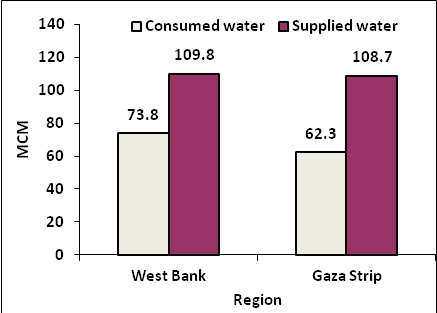Palestinian Central Bureau of Statistics (PCBS)
Press Release by Palestinian Central Bureau of Statistics (PCBS) on World Environment Day
World Environment Day (WED) is celebrated annually on the fifth of June. The theme for this year is "Raise your voice, not the sea level", a campaign to raise awareness of environmental issues in each country.
The Palestinian environment is exposed to various threats to its natural resources such as water, air and soil pollution.
A number of crucial and sensitive issues have been defined and listed in the Palestinian Environment Strategy. These include: the depletion of water resources, poor water quality, depletion of natural resources, destruction of land and soil erosion, air pollution and noise, contamination of the coast and marine environment, decline of the natural environment and biodiversity, distortion of the landscape, and the threat to Palestinian heritage and historical legacy.
Depletion of water resources
A report published by the Palestinian Water Authority (PWA) during October 2013 showed that rainfall constitutes the source of groundwater and surface water resources in Palestine.
Rainfall in Palestine shows considerable spatial and temporal variation, with annual average rainfall of 450 mm/y in the West Bank and 327 mm/y in Gaza Strip. During the 2013/2014 season (1 September 2013 to 11 May 2014) the total average rainfall was significantly lower than average in the West Bank at 383.2 mm/y and higher than average in Gaza Strip at 442.0 mm/y. This translates into a rainfall volume of 2,165 MCM in the West Bank and 162 MCM/Y in Gaza Strip; out of this total about 533 MCM and 76 MCM are estimated to have recharged the groundwater systems in the West Bank and Gaza Strip respectively.
The same report showed that Israel exerts full control over the Jordan River and the available surface water in Palestine is limited to wadi runoff, which is presently barely utilized. The total flow of the West Bank wadis was estimated at 179 MCM in 2011/2012.
Data showed that there are three main groundwater basins in the West Bank; these are all shared with Israel. In 2012, about 64 MCM was extracted by Palestinian pumping wells, while an unsustainable 189 MCM was extracted from the coastal aquifer in Gaza Strip. Around 95% of the pumped water in Gaza Strip is now brackish.
Total local water resources (including wells and springs) available for all purposes for Palestinians were estimated to be 349 MCM for 2012: about 156 MCM in the West Bank and 193 MCM in Gaza Strip.
Israeli measures against water sector
The PWA 2013 report revealed that the Palestinian water situation was exacerbated by the growing population and Israeli measures that limit access to water or improvements to services and sanitation. The percentage of water obtained by Palestinians from aquifers is estimated to be only 15%, while Israelis obtain around 85% of water from these basins. In addition, Israel continues the development and exploitation of shared water basins without reference to the Palestinian population.
Israel has also placed many restrictions on the exploitation of Palestinian water, including the drilling of new agricultural artesian wells, and has destroyed Palestinian water installations. As a result of these measures, the Palestinian per capita share of water consumed for domestic purposes did not exceed 76.4 liters / capita / day in 2012 in the West Bank and 90 liters / capita / day in Gaza Strip.
Around 40% of supplied water is lost
A percentage of supplied water is lost due to technical reasons such as out of date water networks and poorly maintained water installations, in addition to the theft of water in some regions.
Water Supplied and Consumed in Palestine by Region, 2013

Source: Palestinian Central Bureau of Statistics, 2013. Local Community Survey 2013, Main Findings. Ramallah – Palestine.
Climate Change in Palestine: the Black Cloud
Like the rest of the world, Palestine is affected by the adverse effects of climate change. Palestine has seen low rainfall levels, high temperatures and a change in the characteristics of the four seasons. with drought creeping into winter and spring.
The phenomenon of climate change threatens environmental, health, social and economic issues, all of which are detrimental to development plans.
Amounts of carbon dioxide CO2
The quantity of emissions from the energy, agriculture and solid waste sectors in equivalent carbon dioxide emitted during 2011 was estimated at around 4.35 million tons: distributed as 3.51 million tons from the energy sector, 651 thousand tons from agriculture and the remaining 186 thousand tons from the solid waste sector (open burning of solid waste).
Biodiversity
Diversity is a concept that refers to the range of variation or differences among various entities. It is used to describe the number and variety of living organisms.
Biodiversity is important in many fields of life. Protection of biodiversity contributes to the stability of the ecosystem. It is also a natural inherited asset that contributes to sustainable development. Biodiversity is important scientifically in developing and improving global food resources.
Current status of biodiversity in Palestine
Environment Quality Authority (EQA) data reveal that about 2,750 species of plants have been identified in Palestine within 138 families, of which 261 are endemic to Palestine and 53 are special to Palestine.
In the West Bank and Gaza Strip, there are about 2,076 plant species, of which 90 species are threatened with extinction and 636 species are recorded as very rare species.
Israeli Violations are the main causes of Biodiversity deterioration
During 2013, more than eight thousand dunums of land were confiscated from Palestinians and more than 15 thousand horticultural trees were destroyed, causing considerable damage to the Palestinian environment and biodiversity.
The Israeli settlements and military bases also contribute in the biodiversity deterioration since there were 482 Israeli settlements and military bases in the West Bank at the end of 2013.
 عربي
عربي